Vvolt Centauri II Review | It Doesn’t Get Much Easier!
A lightweight commuter e-bike with a powerful and natural motor, automatic shifting, and a fun and responsive ride.
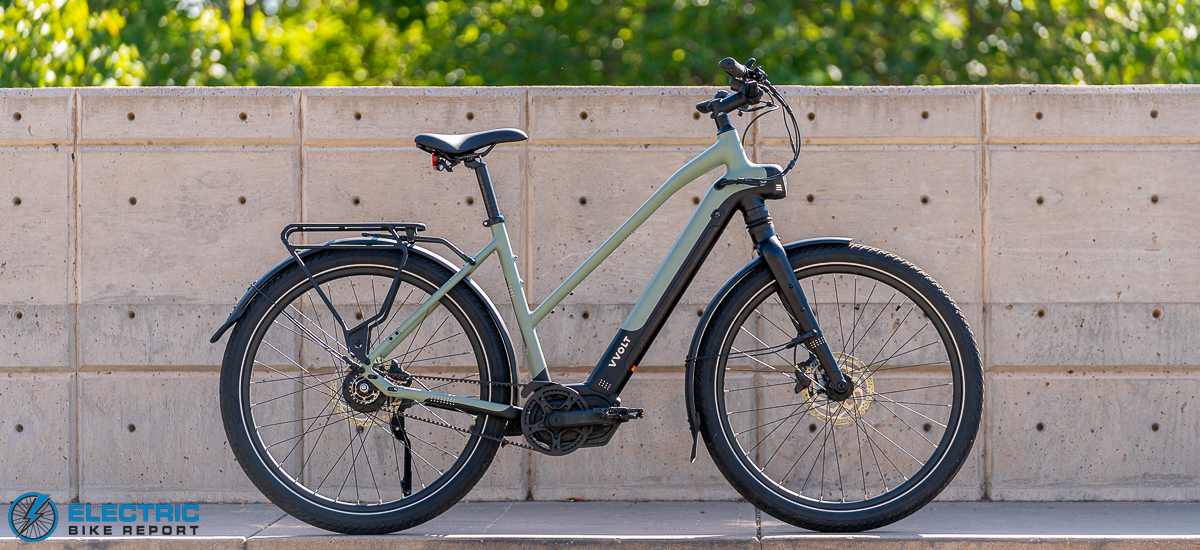
As “bike people,” sometimes it’s easy for us to forget how complex and intimidating e-bikes can be for those who are new to them. First, there’s all the esoteric terminology—things like derailleurs, watt-hours, and Newton-meters. Then, there are practices while riding, like trail etiquette, hand signals, and shifting discipline.
Some of those things should be learned before buying an e-bike, and others may be non-essential for many riders depending on where and how they ride. Good shifting practices are important for all riders—unless you find yourself riding the Vvolt Centauri II, that is.
Why, you may ask?
The Centauri II features an exceptionally user-friendly drivetrain that pairs a 350W mid-drive motor with a 3-speed automatic internal gear hub (IGH). This system requires no action from the rider, as it changes gears at pre-set intervals: roughly 12 and 20 miles per hour. We found it to be effective, easy, and functional for the bike’s Class 3 speeds.
With a Gates CDX belt connecting its mid-drive and IGH, the Centauri II is also remarkably low-maintenance. The internal gears of the IGH are protected from damage and wear, while the durable belt is rated to last twice the mileage of a chain. As a bonus, the system uses no grease, so riders need not worry about getting a messy pant leg.
We liked the Centauri II’s easy-to-use-and-own nature, but we also found its ride to be seriously fun and natural. The bike’s mid-drive responded quickly to deliver smooth power. With a peak of 650W and a surprisingly powerful 120 Nm of torque, it also felt highly capable of climbing hills.
Uphill capability is one of many aspects of the Centauri II we tested. See our full review below to see how the bike performed!
 Pros
Pros- It’s remarkably fun and easy! The Centauri II’s 3-speed automatic transmission allows riders to simply get on and go.
- We enjoyed the bike’s extremely natural feel throughout its five pedal assist settings thanks to its responsive 350W mid-drive motor.
- It has great handling due to its relatively low weight of 55 lbs, 27.5” wheels, and 720-mm handlebars.
- The Centauri is extremely low-maintenance with its combination of a mid-drive motor, Gates CDX belt drive, and sealed internal gear hub (IGH).
- Vvolt offers the model in three frame sizes to fit a wide range of riders from 4’11” to 6’4”.
- It has an impressive total payload capacity of up to 440 lbs.
- A “monoshock” suspension with 30mm of travel smooths the ride without adding lots of weight.
- It’s ready to carry multiple water bottles or gear bags with mounts on the seat tube, top tube, and both forks.
- The bike is sure to turn heads with Vvolt’s signature design, including a two-tone paint job and a down tube that blends seamlessly into the headlight.
 Cons
Cons- The Centauri II offers great looks and cool tech, but considering its price, we hoped to see brake lights and an included cargo rack.
- We’d have preferred a throttle that would help riders start moving instead of the boost button that engages at five mph.
- Battery:36v 13.6ah 490wh, with onboard battery management system, UL2271 tested
- Display: Ananda D16 Full-color display with left-hand remote
- Motor: 120nm torque / 350w (nominal) mid-drive motor by Ananda, 650w peak, custom programmed for Vvolt
- Headlight:Vvolt Multivision Integrated 65LUX front
- Taillights:Vvolt Multivision Integrated 220º vis rear
- Pedal Assist: 4 Levels
- Claimed Range: Up to 60 miles
- Throttle:BOOST button delivers 4-second max assist while pedaling between 5-20mph
- App:N/A
- UL Certification:UL 2271 tested
- Claimed weight: 50 lbs
- Tested Weight: 55 lbs
- Rider height range: 4’9”-5’8” (S), 5’4”-5’10” (M), 5’8”-6’4” (L)
- Total payload capacity: 440 lbs
- Brakes: Shimano MT200 hydraulic disc brakes, 2-piston calipers, 180mm rotors
- Fenders: Aluminum
- Fork: Vvolt custom monoshock suspension, 30mm travel
- Frame: Aluminum Alloy
- Drivetrain:Gates CDX, 46T chainring, 22T cog, Gates 120T belt, Autoshift3 Automatic three-speed rear hub transmission
- Grips: Ergonomic locking grips
- Saddle: Vvolt IsoStac hybrid gel comfort saddle
- Handlebar:Alloy, 31.8mm clamp, 720mm width, 15mm rise x 12º sweep
- Kickstand: Aluminum 40mm direct-mount
- Pedals: Wellgo Alloy platform with reflectors
- Tires: CST 2.25″ city tire with reflective sidewalls and puncture-resistant belt
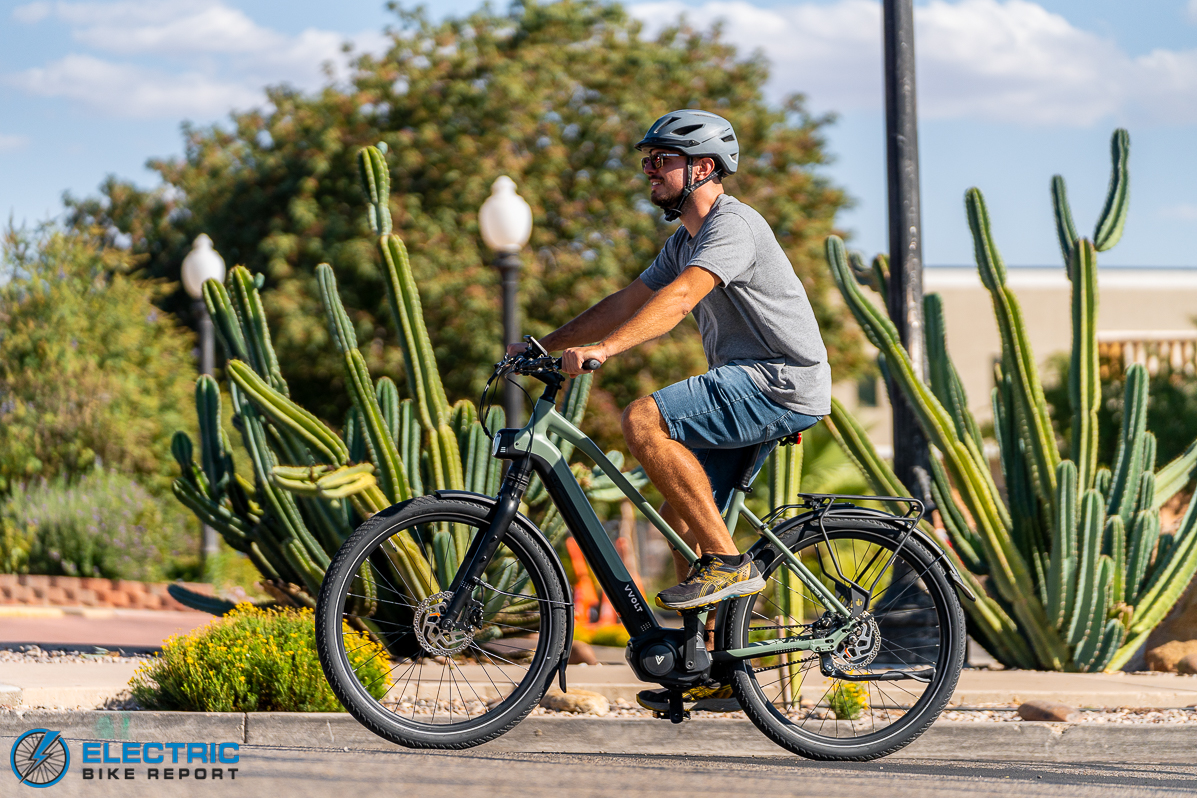
We found the Centauri II to be comfortable, cool-looking, and extremely easy to operate.

A custom-branded 350W Ananda mid-drive motor provides a natural feel with 120 Nm of torque to assist on hills.
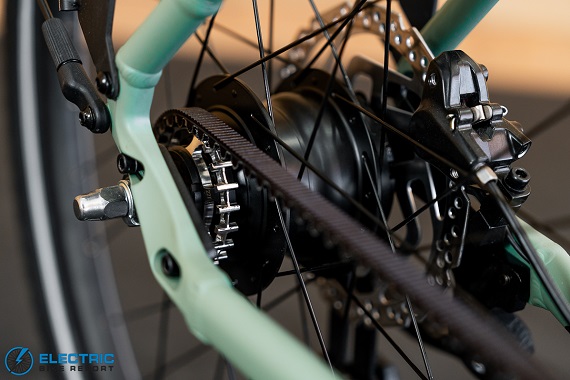
The bike’s rear hub includes its three-speed automatic transmission or internal gear hub (IGH).
Vvolt Centauri II Review: Speed Test

The Centauri II has a maximum speed of 28 miles per hour and a pedal assist system (PAS) with five power levels: Chill, Eco, Tour, Sport, and Turbo. We tested the speed of each setting by riding in each mode on a flat section of southern Utah’s network of paved shared-use paths. The speeds recorded in each setting are shown above.
It’s worth noting that Chill mode places a limit on the bike’s speed; while Vvolt advertises this at 12 mph, our bike’s motor seemed to stop at 14 mph. The bike’s other four assist levels are not limited in speed, so riders could potentially reach 28 mph depending on the effort applied to the pedals.
The data from this test shows a linear pattern that reflects consistent increases in speed between settings. This sort of linear pattern is what we hope to see in this test, as it corresponds with an intuitive feel; the amount of power felt when increasing the level of pedal assist is expected and controlled.
In my experience, the Centauri did indeed feel intuitive to use. The bike’s higher power levels were effective at reaching higher speeds, but most of the time, I felt the power levels of Chill or Eco mode were plenty for general/casual riding. I liked the natural feel of the responsive motor and the easy experience without the need for shifting.
The IGH’s automatic shifting felt appropriate at 12 mph, though pedaling started to feel somewhat loose by the time I reached 20 mph. With tools, it is possible to adjust the points at which the system shifts but not the interval between them. A change to 11 mph/19 mph might be slightly more ideal than the current setting, though this is also a personal preference.
Ultimately, the Centauri II performed well in our speed test with a highly natural feel and great power and speed distributions across its PAS.
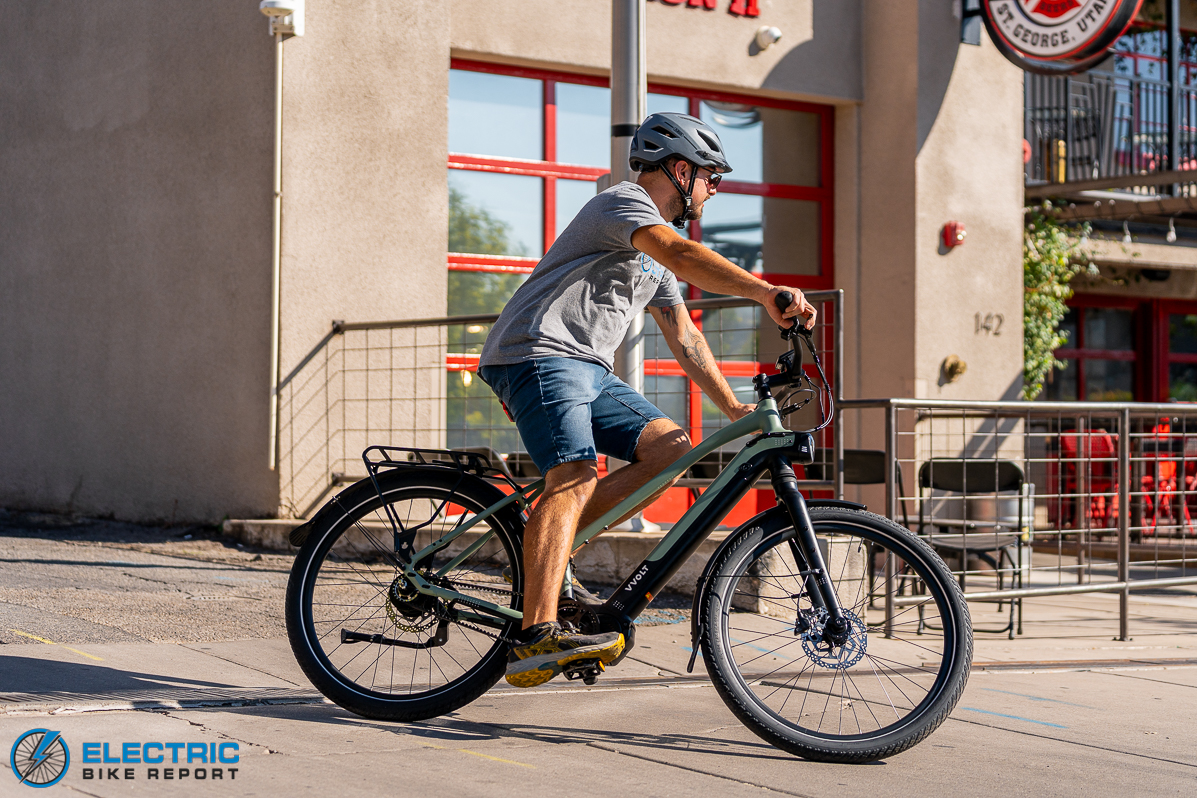
With wide handlebars, 27.5” wheels, and a relatively lightweight frame, the Centauri II is fun and nimble!

The Centauri’s down tube hosts a fully-integrated 490-Wh battery with a security lock.

The seat stay features a pass-thru allowing the Gates CDX belt to be replaced (it lasts twice as long as a chain).
Vvolt Centauri II Review: Range Test

We tested the Centauri II’s motor efficiency and range using the method described above. Our tested minimum and maximum results are also displayed in the graphic, along with those from a selection of similar models we tested previously.
For the Chill mode/maximum range test, we ensured that our speed remained below the threshold where the motor turned off (14 mph, as discussed in the Speed Test section above).
Our results of 23.4 and 64.1 miles are both high practical numbers—especially considering the Centauri’s specs—but they are somewhat below average when compared to similar e-bikes with mid-drive motors we tested previously. We were pleased, however, to exceed Vvolt’s advertised range of up to 60 miles!
350W mid-drive motors are relatively uncommon in our experience, so the pool of bikes used for comparison included mostly those with 250W mid-drives and a few with 500W motors. Those bikes averaged 32.7 miles in the high-power test and 70.4 miles in the low-power test. The Centauri was 9 miles and 6 miles below average, respectively.
With the greatest difference in the Centauri’s Turbo mode test, it’s likely that two factors came into play. First, this bike’s 350W motor was more powerful than most of the others used for comparison, so it consumed battery charge faster. Second, its 490-Wh battery is smaller than average (578 Wh), so there was simply less fuel to use.
In my testing, I found myself only needing full power when climbing tough hills (or maximizing my speed). As such, riders using a conservative/moderate level of power will likely be able to get many miles from a single charge. Our Turbo mode result should cover most commutes; multiple trips may be possible when using the mid or low levels of assist.
Vvolt Centauri II Review: Hill Test
The method and location used for our Hill Test are both described in the graphic above, along with the Vvolt Centauri II’s test results.
The bike performed well in this test when compared with similar models we tested—once again, mostly commuter-style e-bikes with 250W mid-drives but a few with 350W and 500W motors. Those bikes averaged 1:36, so the Centauri II was potentially slightly faster than average (the difference is within our margin of error).
One major factor likely gave the Centauri II an edge in this test: its Ananda motor’s high torque rating. With 120 Newton-meters (Nm) of torque, the Centauri’s 350W motor is more comparable to what we see commonly with 500W motors instead of 250W or other 350W motors.
Higher torque ratings usually correspond with better Hill Test results when pedaling up Hell Hole Trail. With the bike weighing in at 55 lbs, its below-average weight likely helped it out as well.
In my personal testing, I used our secondary location, called Pilot Hill, to test the bike’s climbing ability in its first and second gears. My goal was to see how much of a difference there would be in both feel and my time to the top when using the same assist level (Turbo mode) but different gears.
With most of the trip in first gear, my climb took 1:34 at 12.1 mph. When using primarily second gear, my time was 1:13 at 15.5 mph. As expected, my results in second gear were faster—by about 21 seconds and 3.4 mph—but there was a night and day difference in terms of feel.
The bike’s second gear provided more resistance on the pedals, so my second trip was overall a more active experience. In first gear, however, the same trip felt remarkably more relaxed and low-effort. Both trips were relatively easy, though, so the Centauri II proved to be capable in both of its lower gears.
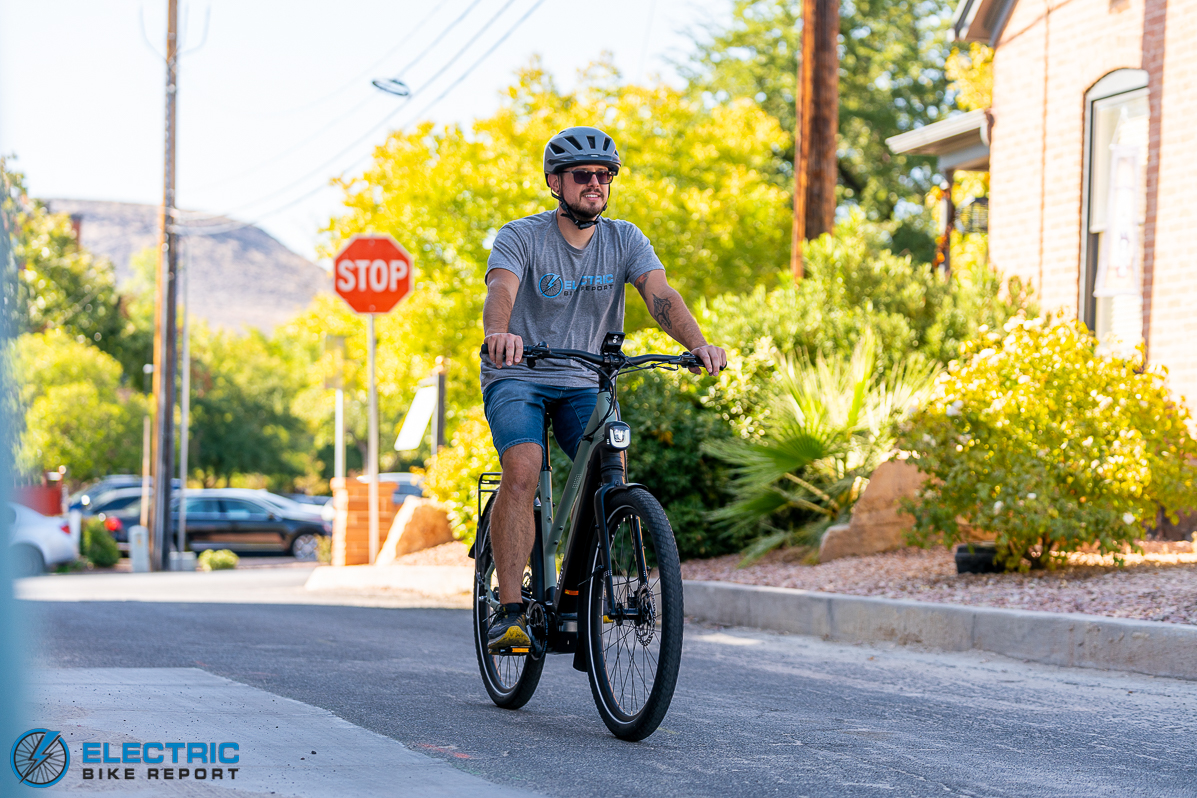
The Centauri II is available in three frame sizes with a comfortable, mostly upright riding position.

Shimano MT200 hydraulic brakes feature 180mm front and rear rotors.

The bike’s 27.5×2.25” CST street tires provided traction and comfort.
Vvolt Centauri II Review: Brake Test
We tested the effectiveness of the Centauri II’s hydraulic disc brake system using the process explained above. Its average stopping distance after three tests was 23’2”. Similar models we tested averaged 22’5”, so Vvolt’s commuter was slightly slower to stop than average, but it was still well within the normal and expected range of results.
In my testing, the brakes felt effective, and the bike felt controlled when coming to a stop. The Shimano MT200 brake system with 2-piston calipers and 180mm rotors didn’t have quite as much bite as I expected, but it responded quickly with good modulation.
Additionally, the Centauri did not deviate much from its line of travel when braking, and I did not experience much skidding or fishtailing. This kept it feeling controlled, safe, and stable. As such, we deem its brake system safe and effective!

Wide 720-mm handlebars provide stability and precision when steering.

While the bike does not have brake lights, it features an integrated tail light beneath the saddle.

We dig the custom integrated headlight that blends seamlessly into the bike’s down tube.

The ride is softened by a “monoshock” suspension with 30mm of travel.
Vvolt Centauri II Review: Ride Quality
While more subjective than our data-based tests, discussing ride quality (how a bike feels to ride) is every bit as important. In this section, we will discuss many aspects of the ride, including the Centauri II’s sizing and fit, overall comfort, suspension, handling, user interface, etc.
Vvolt manufactures this model in three sizes: S/M, M/L, and L/XL. The S/M fits riders from 4’9” to 5’8”, while the M/L is sized for those between 5’4” and 5’10”, with the L/XL accommodating a range from 5’8” to 6’4”.
We tested the L/XL frame, which was sized appropriately for my height of 5’11”. With 8” of saddle height adjustment, I had full leg extension for pedaling efficiency. The bike’s geometry pitches the rider forward somewhat, though I found this position to be comfortable and not too aggressive.
Overall, I found the bike to be comfortable, thanks to its gel saddle, ergonomic rubber grips, and wide handlebars. The handlebars, in particular, were a highlight—providing excellent stability and steering control. Thanks to these (and the bike’s relatively low weight), its handling was fast and responsive, giving the bike an agile feel.
The bike features a proprietary “monoshock” suspension in the head tube; this mechanical coil-based system provides 30mm of travel to smooth bumps and dips. I found that it generally felt good when riding over small imperfections, but it seemed a bit stiff and bottomed out when riding over larger obstacles, such as the edge of a sidewalk.
Instead of a throttle, the Centauri II has a Boost button mounted on the right handlebar. After a short delay, this button provides motor power for four seconds; our test bike would provide a low-power boost from a standstill or a max-power surge when riding above five mph. Our contact at Vvolt said the help at startup would not exist with 2025 models.
I noticed that once the Boost function was engaged, applying the brakes did not cut the motor’s power output, so there were a few times when the bike felt like it was starting to get away from me. We encourage Vvolt to include a motor cutoff feature for safety.
We also appreciate the brand’s efforts to encourage a more active experience, but we believe most riders will prefer a throttle over the Boost button. From personal experience, I can attest that I use the throttle most when picking up from a stop at an intersection. As such, we’d prefer a traditional throttle, even if it were limited to, say, 10 mph.
Otherwise, the bike’s user interface is minimalistic and straightforward; aside from the brake levers, display, and button panel, its cockpit is clean and simple. I appreciated the bike’s color display and the fact that its PAS settings are color-coded for ease of reference.
I also really liked the Centauri’s styling; the sleek and streamlined fusion of the down tube and headlight is a great touch on Vvolt’s newest models. It’s important for a brand to have a visual identity, and Vvolt successfully found theirs. Looks are certainly subjective, but I’m absolutely a fan!
Considering the Centauri II’s price point of roughly $3k at the time of writing, I hoped to see brake lights instead of a simple tail light; this would be an appreciated upgrade in the future. Our test bike was equipped with an optional cargo rack that we’d appreciate having included with the base cost as well.
Otherwise, the bike’s quick handling, easy operation, and responsive motor output were defining features that served to elevate its ride quality to an uncommon degree. It was a joy to be able to hop on the bike and simply ride without thinking about anything beyond the initial pedal assist level (or switching in the event of a hill).
Overall, the Centauri II’s ride quality is excellent, making it an easy bike to recommend.

Each of the bike’s five PAS settings is color-coded in the display.

We found the locking ergonomic rubber grips to be secure and comfortable.

While the Centauri does not have a throttle, it has a Boost button that delivers full power for 4 seconds.

The optional rear cargo rack can carry up to 44 lbs.
Vvolt Centauri II Review: Summary / Where to Buy
Like our team at Electric Bike Report, Vvolt is a brand comprised of “bike people.” To quote the company’s webpage directly, “Our products are designed to be intuitive, easy to control, maintain, and enjoy, regardless of one’s ability level.” Having had the opportunity to test a handful of Vvolt’s e-bikes, I can attest that the Centauri II fulfills this mission.
Vvolt clearly prioritized fun, comfort, low maintenance, and especially ease of use with the Centauri II. As the bike’s test results showed, it also performs well; the bike held its own when compared to many of its peers, and it excelled in the areas of its intuitive programming and its overall ride quality.
Considering the bike’s price point of around $3k, we challenge Vvolt to include brake lights and a cargo rack in the future. Additionally, we believe most riders would prefer a traditional throttle with the ability to power the bike from a complete stop instead of the included boost button, even if the throttle were limited in speed.
We happily recommend the Centauri II as a daily-use e-bike for the morning commute. It’s also well-suited to riders seeking a functional, active, and natural-feeling bike that’s easy to use and maintain.
Finally—while this is a lot less important—I also think it’s an excellent option for anyone wanting a cool-looking bike that stands out from the crowd and/or one that incorporates some uncommon technology in the form of its automatic transmission.
Happy Riding! Make sure to let us know if you have any questions or if you think we left anything out in our comments section in this review of the Vvolt Centauri II.



My wife and I plan to buy one of these for each of us this year. We had to leave our e-bikes in Australia when we moved to the USA, and we miss them. This looks like a great bike for use year-round, especially with the nice fenders.
Great choice! Let us know how you like them once you get a chance to ride them!